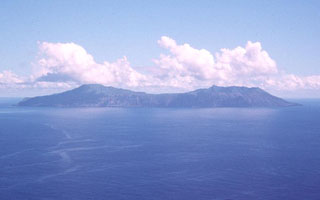Report on Anatahan (United States) — 30 January-5 February 2008
Smithsonian Institution / US Geological Survey
Weekly Volcanic Activity Report, 30 January-5 February 2008
Managing Editor: Sally Sennert.
Please cite this report as:
Global Volcanism Program, 2008. Report on Anatahan (United States) (Sennert, S, ed.). Weekly Volcanic Activity Report, 30 January-5 February 2008. Smithsonian Institution and US Geological Survey.
Anatahan
United States
16.35°N, 145.67°E; summit elev. 790 m
All times are local (unless otherwise noted)
The USGS reported that elevated seismic tremor levels at Anatahan were detected during the last week in January through 5 February. Observations of satellite imagery showed that the lake in the E crater had disappeared, and steam and sulfur dioxide plumes drifted generally W and SW. On 3 February, an ash plume rose to an estimated altitude of below 2.3 km (7,500 ft) a.s.l. and drifted W. On 5 February, the USGS announced that the Volcanic Alert Level was raised to Watch and the Aviation Color Code was raised to Orange as a result of the observed ash emissions.
Geological Summary. The elongate, 9-km-long island of Anatahan in the central Mariana Islands consists of a large stratovolcano with a 2.3 x 5 km compound summit caldera. The larger western portion of the caldera is 2.3 x 3 km wide, and its western rim forms the island's high point. Ponded lava flows overlain by pyroclastic deposits fill the floor of the western caldera, whose SW side is cut by a fresh-looking smaller crater. The 2-km-wide eastern portion of the caldera contained a steep-walled inner crater whose floor prior to the 2003 eruption was only 68 m above sea level. A submarine cone, named NE Anatahan, rises to within 460 m of the sea surface on the NE flank, and numerous other submarine vents are found on the NE-to-SE flanks. Sparseness of vegetation on the most recent lava flows had indicated that they were of Holocene age, but the first historical eruption did not occur until May 2003, when a large explosive eruption took place forming a new crater inside the eastern caldera.

